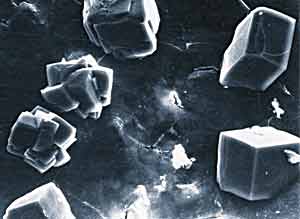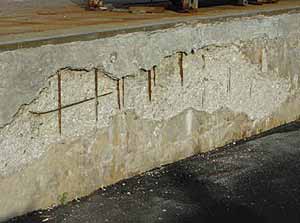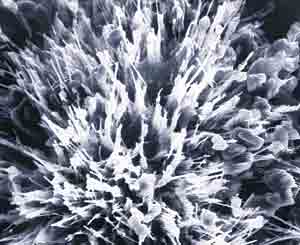Concrete Waterproofing with Crystalline Technology
When crystalline waterproofing is applied to the surface, either as a coating or as a dry-shake application to a fresh concrete slab, a process called chemical diffusion takes place. The theory behind diffusion is that a solution of high density will migrate through a solution of lower density until the two equalize.
Thus, when concrete is saturated with water prior to applying crystalline waterproofing, a solution of low chemical density is also being applied. When crystalline waterproofing is applied to the concrete, a solution of high chemical density is created at the surface, triggering the process of chemical diffusion. The crystalline waterproofing chemicals must migrate through the water (the solution of low density) until the two solutions equalize.
The crystalline waterproofing chemicals spread through the concrete and become available to the byproducts of cement hydration, allowing the chemical reaction to take place. A crystalline structure is formed, and as the chemicals continue to migrate through the water, this crystalline growth will form behind this advancing front of chemicals. The reaction will continue until the crystalline chemicals are either depleted or run out of water. Chemical diffusion will take these chemicals about 12 inches into the concrete. If water has only soaked two inches into the surface, then the crystalline chemicals will only travel two inches and stop but, they still have the potential to travel 10 inches further, if water re enters the concrete at some point in the future and reactivates the chemicals.
Instead of reducing the porosity of concrete, like water reducers, plasticizers, and superplasticizers, the crystalline formation engages the material filling and plugging the voids in concrete to become an integral and permanent part of the structure.
|
Because these crystalline formations are within the concrete and are not exposed at the surface, they cannot be punctured or otherwise damaged like membranes or surface coatings. Crystalline waterproofing is highly resistant to chemicals where the pH range is between three and 11 under constant contact, and two to 12 under periodic contact. Crystalline waterproofing will tolerate temperatures between -25 degrees Fahrenheit (-32 degrees Centigrade) and 265 degrees Fahrenheit (130 degrees Centigrade) in a constant state. Humidity, ultraviolet light, and oxygen levels have no impact on the products ability to perform.
|
Crystalline waterproofing offers protection against the following agents and phenomena:
- Inhibits the effects of CO, CO2, SO2 and NO2, the gasses responsible for the corrosive phenomenon known as ‘carbonation.' Carbonation is the process where exterior gasses create a corrosive phenomenon that softens the surface layers of the concrete. Carbonation testing shows that the multiplicative crystalline formations also reduce the flow of gases into concrete, thus significantly retarding the carbonation at the surface in which the alkalinity is reduced and the surface layer is softened.
- Protects concrete against alkali aggregate reactions (AAR) by denying water to those processes affecting reactive aggregates.
- Extensive chloride-ion diffusion testing shows that concrete structures protected with a crystalline waterproofing treatment prevent the diffusion of chlorides. This protects reinforcing steel and prevents deterioration that could occur from oxidation and expansion of steel reinforcement.
|
Michael Brown, P.E., principal with Golder Associates in Seattle, has used crystalline waterproofing in numerous applications, but notably on the Blackbird mine remediation project near Salmon, Idaho, which has very low pH acidic mine water flowing through concrete structures. "We use crystalline waterproofing technology as an additive to concrete to reduce permeability and provide protection for the epoxy coated reinforcing bar," said Brown.
The more traditional methods of protecting concrete, such as membranes and other coatings, may still leave it susceptible to water and chemical damage. Only with the addition of crystalline technology can the pores and microcracks that normally result from the process of setting and curing, allow concrete to be sealed.












